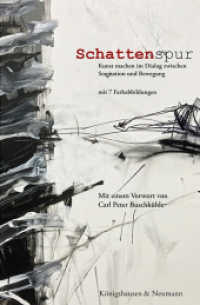- ホーム
- > 洋書
- > ドイツ書
- > Mathematics, Sciences & Technology
- > Earth Science
- > geography
Full Description
This book addresses the changing contemporary language worlds in three major contexts. It first discusses how the language landscape maps of cities are changing as a result of increased migration, globalization and global media. These features are evident in place names and place name changes as well as the densities and frequencies of language spoken and used in texts. The second section discusses how the state itself is responding to both indigenous and heritage groups desiring to be included and represented in the state's political landscapes and also expressions of art and culture. In the third section, the authors address a number of cutting-edge theses that are emerging in the linguistic geography and political words. These include the importance of gender, anthropogenetic discourse, the preservation of endangered languages and challenges to a state's official language policy. Through including authors from nine different countries, who are writing about issuesin twelve countries and their overlapping interests in language mapping, language usage and policy and visual representations, this book provides inspiring research into future topics at local, national, regional and international scales.
Contents
Mapping Language Landscapes: 1. Adam Stone, Erik Anonby: A Typology for Evaluating Language Maps.- 2.Tekabe Legesse Feleke: Issues in Classifying and Mapping the Semitic Languages of Ethiopia.- 3. Christoph Purschke: Exploring the Linguistic Landscape of Cities Through Crowdsourced Data.- 4. Shangyi Zhou: Changing Attitudes of Beijingness to Westernized Place Names in Beijing: From the Semi-Colonial Period to Postmodern Twenty-First Century.- 5. Lisa M. Butler Harrington: Thematic Categories for Place Names: Topology Typology.- Language, Culture and Politics: 6. Seif Da'Na, Laura Khoury: Palestine's Land Centrality and the Instrumentality of Historical Language.- 7. Cecil Seethal: The State of Languages in South Africa.- 8. John Elliott, Raina Heaton: Languages and Language Politics in the Paraguayan Chaco.- 9. Teresa Wai See Ong: Reimaging the Art Scene in George Town, Penang.- 10. Laurie Brinklow, Rilla Marshall, Brenda Whiteway: Exploring Climate Change Through the Language of Art.- The Functions of Language on a Local and a Global Scale: 11. Ram Nandan Prasad Sinha: Preservation of Magahi Language in India: Contemporary Developments.- 12. Lauren E. Deal: Learning Indigenous Languages in Buenos Aires, Argentina.- 13. Michael M. Kretzer, Teresa Wai See Ong: Reclaiming Transformation for Inclusive and Multilingual Education through Linguistic Landscape (LL) in South Africa and Malaysia.- 14.Unn Røyneland, Elizabeth Lanza: Dialect Diversity and Migration: Disturbances and Dilemmas, Perspectives from Norway.- 15. Maganat Shegebayev: Rise of English as Business Lingua Franca at the Turn of the Century: An Overview.- 16. Mary-Caitlyn Valentinsson: English and Bivalent Class Indexicality in Buenos Aires, Argentina.- 17. Jennifer C. Langill: The Nature of Gender Relations: The Changing Language of Gender amid Anthropogenic Climate Change in Amazonian Peru.




![A Grammar of Bardi (Mouton Grammar Library [MGL] 57) (2013. XLVIII, 820 S. 240 mm)](../images/goods/ar/work/imgdatak/31102/3110278154.jpg)



